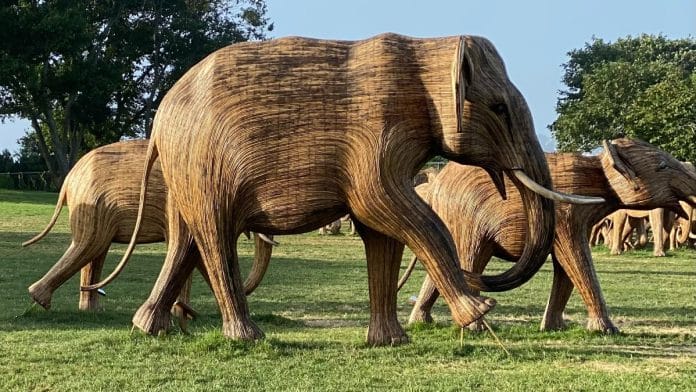New Delhi: One hundred life-sized sculptures of Indian elephants made from the invasive lantana camara plant are touring the United States, starting with New York City.
This ‘Great Elephant Migration,’ as it is known, is an initiative of Tamil Nadu-based The Real Elephant Collective (TREC) which brings together over 200 people from indigenous communities of Karnataka, Tamil Nadu, and Kerala including Soligas, Kattunayakans, Betta Kurumbas, Mullukurumbas, and the Paniyas.
Sculpted by artisans from these communities using a carbon-neutral approach, the sculptures are auctioned in different locations around the world to both raise awareness about the coexistence of humans and wildlife and support conservation efforts in the Nilgiri Biosphere Reserve.
“The creation of the sculptures provides financial stability, status, and pride to 200 members of the tribes who coexist with the real wild elephants the herd is based on,” reads the Great Elephant Migration brief.
CG @binaysrikant76 joined the “The Great Elephant Migration” from Nilgiri Hills to New York City; 100 life-sized elephant sculptures made by Indian artisans narrating a story of harmonious coexistence of elephants & people in India, also promoting better understanding of Indian… pic.twitter.com/ApUWNPxNCK
— India in New York (@IndiainNewYork) September 6, 2024
The initiative which started a little over nine years ago in Thorapalli village in the Nilgiris, has made over $500,000 through the exhibition and sale of these Lantana elephants. Each elephant is linked to a conservation-based NGO and the proceeds from its sale go directly to benefit the NGO.
Started by Dr Tarsh Thekaekara, a conservationist and academic at the National Centre for Biological Sciences, The Real Elephant Collective (TREC) has toured Bangalore, Cochin, the United Kingdom, and now the US with their elephant sculptures over the past few years.
Their goal is to sell 1,000 such lantana elephants to raise $10 million for the cause of biodiversity conservation across the globe.
Also Read: Illegal wildlife trade persistent & pervasive, warns UN crime agency, calls for urgent action
Dual role of Lantana elephants
The Lantana elephants stand not just to represent Indian elephants that inhabit the Nilgiris, Bandipur, and Western Ghats region in southern India but also the sustainable use of the lantana camara plant.
It is one of the world’s ten most invasive species as recognized by the IUCN, and threatens the existence of these very elephants by rapidly taking over the protected forests where they reside.
By utilising the lantana camara plant to make elephant sculptures, the TREC aims to achieve the dual purpose of spreading awareness about threats to elephant habitats while also clearing the forests in Nilgiris of the invasive species.
According to the TREC website, the lantana species has taken over 40 percent of India’s forests, and a 2019 study also says that the worst lantana infestations are in the South in Nilgiris, Western Ghats, Coorg, and Wayanad regions. Since the species doesn’t allow many other plant species to grow, it results in reduced tree cover which then results in reduced biodiversity. Its leaves are poisonous for many animals including cattle and goats, and it also has a propensity to fire thus leading to more forest fires.
The TREC, by its initiative, uses lantana plants, steel, and varnish to make its elephants which differ in size from 5ft to 15ft—from baby elephants to matriarchs. However, in the pursuit of being a ‘carbon-neutral’ project, the TREC also supports widespread lantana removal across southern India.
They plan to sequester 2,625 tonnes of carbon dioxide by 2025 through support of lantana biochar conversion projects i.e. the process of burning lantana camara in low-oxygen environments to produce organic charcoal that improves soil health and nutrients. Therefore, the carbon sequestration benefits of the biochar process will offset the carbon that is generated during the production, export, and sale of the lantana elephants.
The Great Elephant Migration
While the TREC started in Tamil Nadu’s Nilgiris, its global turn has been supported by other conservationists, artists, and academics including theatre artist Shubhra Nayar, and Ruth Ganesh, UK-based conservationist and trustee of the UK-based NGO Elephant Family. The initial runs in Indian cities in Bangalore and Cochin did not aim to sell any elephants, instead focusing on just exhibitions.
However, in the UK and now the US where they plan on visiting five different locations across the country, the goal is to auction the elephants to generate money for global conservation NGOs such as The Perfect World Foundation, One Earth, Save the Elephants, and the Wild Bird Fund.
According to TREC’s website, the NGOs chosen are ones that focus on community-led conservation strategies—just like the TREC itself is doing with indigenous tribes in South India.
Global Indian brands such as Anita Dongre and Sabyasachi also have supported this initiative, and the sculptures themselves have found their way into the Indian Prime Minister’s residence and the Buckingham Palace.
(Edited by Amrtansh Arora)
Also Read: Tourist rush into a sleepy Tamil Nadu town causing wildlife roadkill. 2 ecologists helping






